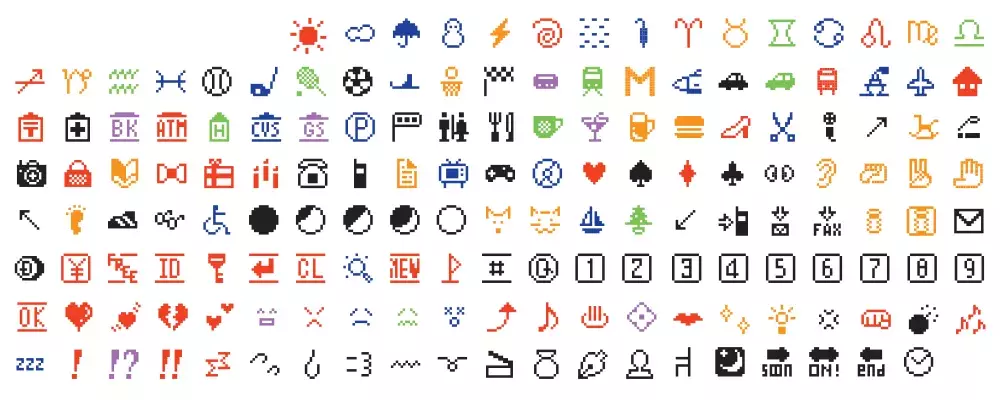
Whether as universal as a heart or as specific as a female mountain-biker, emoji have come to play an essential role in our digital language. The symbols we use daily in our text messages, emails, and social media posts have become more than just a cute novelty, or a tool for saving time — they help convey nuance, show care, and add a layer of creativity and playfulness to even the simplest messages. Emoji quickly became a global phenomenon, but their history starts in Japan and connects to a far longer tradition of pictorial language and playful visual symbolism in other mediums.
Though there is some debate over who created the very first official emoji set for mobile phones, the earliest black-and-white set was introduced in 1997 by the team behind the J-Phone (a company that would eventually be acquired by other parent companies including SoftBank). In 1999, a designer named Shigetaka Kurita created a full color set of 176 emoji for the mobile phone provider NTT DOCOMO and their pioneering “i-mode” software. His initial set of emoji (“e” for picture, “moji” for character) was created with a limited canvas of 12 x 12 pixels per image but managed to cleverly portray low-resolution symbols that remain emoji favorites today such as a heart, a martini glass, and a smiley face. They won over the public instantly, and were adopted across Japanese mobile phone platforms (often in competition with each other) in the next decade. After much internal debate, the global Unicode Consortium officially incorporated emoji into the international technology standards for digital Communications in 2010, launching with 722 emoji. From then on, emoji began to exponentially multiply, with nearly 3,000 today. The 1999 NTT DOCOMO emoji set were added to the permanent collection of the Museum of Modern Art in New York in 2016, cementing their place in art and design history.
Kurita has said that his work took inspiration from sources such as weather symbols and street signs, as well as the obvious: the pictographic characters in the Japanese script kanji, adopted from Chinese characters which were first developed as early as the 2nd millennium BCE. Emoji have also been compared to Egyptian hieroglyphs, which date back to the 3rd millennium BCE, as well as the many experiments to depict images in type that began with the birth of the printing press in the West. By the 1980s and the dawn of computer science, “emoticons” such as :-), became commonly used on message boards and emails in the West. In Japan, a parallel development of “kaomoji” (literally “face characters”) which were more horizontal, instead of vertical in orientation, such as (*_*). When mobile phones came on the scene, it’s perhaps unsurprising that the ancient human desire for “picture characters” drove the development of emoji, but it’s unprecedented how quickly a system was standardized (by Unicode) for a more or less global pictorial language.
However, the more we use emoji, the clearer it becomes that across cultures, languages, and individual readers, a single emoji can have many meanings. For instance, an emoji like the “hot springs” (onsen) symbol which would be easily recognized in Japan, but which many Westerners assume means a “steaming cup of coffee.”

Perhaps anticipating these challenges, some software developers have been cultivating more unique and personalized sticker packs. The LINE app, first launched in Japan, was one of the first to introduce stickers in their service nearly a decade ago, with signature characters like the Cony rabbit animated in different ways to convey meaning, as well as launching a “creator’s studio” where independent artists could upload and monetize their designs. Other platforms like China’s WeChat and South Korea’s Kakao Talk also expanded to wildly popular sticker packs, and more recently Facebook Messenger and other Western platforms have followed suit.
But for simplicity, ease of use and universal integration with all messaging platforms, it seems that emoji still rule. Each year, more emoji are adopted by the Unicode Consortium — some due to community advocacy, as in the case of adding more diverse representations of gender, race, and culture. Due to the coronavirus pandemic, the new emoji for 2020 have been delayed, but we can still all celebrate World Emoji Day on July 17 (initiated in 2014 by the founder of Emojipedia, Jeremy Burge, on a date chosen because it’s the date featured in the Apple “calendar” emoji). What festive emoji will you be using to celebrate?
Emoji credit: Emoji designed by OpenMoji – the open-source emoji and icon project. License: CC BY-SA 4.0

